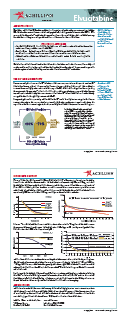
Experimental
NRTI Elvucitabine Suppresses HIV as Well as Lamivudine at 48 Weeks
While novel classes of antiretroviral drugs such as integrase inhibitors and CCR5 antagonists have received the most attention at recent HIV conferences, new agents in older classes also continue to make their way through the pipeline. At the 48th International Conference on Antimicrobial Agents and Chemotherapy (ICAAC 2008) last week in Washington, DC, researchers presented the latest data on elvucitabine (also known as ACH123,446), a cytosine analog nucleoside reverse transcriptase inhibitor (NRTI) being developed by Achillion Pharmaceuticals. Previous laboratory studies demonstrated potent in vitro activity against wild type HIV-1. In the prospective Phase 2 study described at the meeting, 77 treatment-naive participants in the U.S. and India were randomly assigned to received 10 mg elvucitabine or 300 mg lamivudine (3TC; Epivir), both administered once daily with 600 mg efavirenz (Sustiva) and 300 mg tenofovir (Viread). Baseline characteristics were similar between the 2 treatment groups. Most participants (about 80%) were men, the mean age was about 37 years, about 56% were white, about 25% were Asian, and about 17% were black. The mean baseline CD4 count was about 325 cells/mm3 and viral load was about 4.8 log10 copies/mL. All but 3 randomized participants had both baseline and post-baseline HIV RNA measurements. Results
These
findings led the researchers to conclude that, "Elvucitabine administered
in combination with tenofovir and efavirenz demonstrates substantial anti-viral
activity." Orlando Immunology Ctr., Orlando, FL; Dr. Saple's Clinic, Mumbai, India; Clinical Res. Puerto Rico, San Juan, Puerto Rico; YRGCare VHS, Chennai, India; Hlth. for Life Clinic, Little Rock, AR; Private Practice, Dallas, TX; Cr. for the Prevention and Treatment of Infections, Pensacola, FL; Achillion Pharmaceuticals, Inc., New Haven, CT. 11/07/08 Reference |
The
material posted on HIV and Hepatitis.com about ICAAC 2008 and IDSA 2008 is not
approved by nor is it a part of ICAAC 2008 or IDSA 2008. |
![]()
